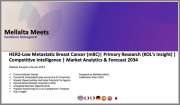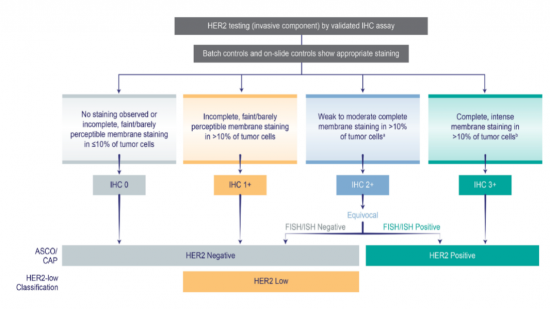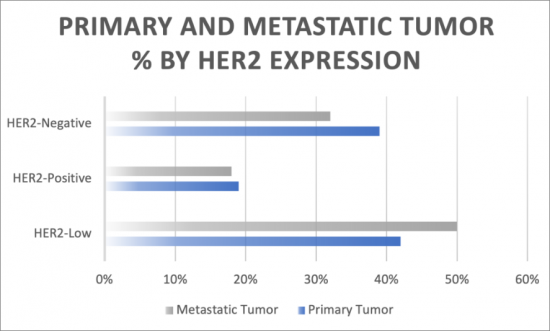
|
시장보고서
상품코드
1349826
세계의 HER2 저발현 전이성 유방암(mBC) 시장 : 1차 조사(KOL 인사이트)-시장 인텔리전스-역학 및 시장 예측(-2034년) |
||||||
HER2 저발현 전이성 유방암(mBC, HER2-Low Metastatic Breast Cancer) 시장은 화학 요법, 내분비 요법 및 트라스투주맙 데룩스테칸(성분명: 인핸서투)과 같은 표적 요법에 의해 크게 기여하고 있습니다. 2034년까지 새로운 신흥 치료법의 도입은 HER2 저발현 전이성 유방암 치료제 시장에 급격한 변화를 가져오는 주요 분기점이 될 것입니다. 연구 국가 (미국, 프랑스, 독일, 이탈리아, 스페인, 영국 및 일본)에서 HER2 저발현 전이성 유방암 치료를 위한 신흥 치료법의 판매는 2020-2034년 연구 기간 동안 높은 성장을 경험할 것입니다.
HER2 저발현 전이성 유방암의 치료법은 급속히 진화하고 있는 것으로 보입니다. 최근의 임상시험에서는 CDK4/6 억제제와 내분비요법의 병용이 표준 1차 치료로서 효과적임이 입증되었습니다. 또한, PI3K 억제제와 AKT 억제제의 사용도 임상시험에서 검토되고 있으며, 가까운 장래에 추가적인 치료 옵션을 제공할 수 있습니다.

HER2 저발현 전이성 유방암은 유방암의 이해와 치료에서 큰 전환을 의미합니다. 지금까지 유방암은 HER2 발현 정도에 따라 HER2 양성 또는 HER2 음성으로 분류되었습니다. 그러나 현재 유방암의 50% 이상이 HER2 면역조직화학(IHC) 점수가 +1 또는 +2이고 형광 현장 혼성화(FISH) 검사에서 음성인 '인간 표피 성장 인자 수용체 2(HER2) 저 유방암(BC)'으로 정의되고 있습니다. IHC/ISH는 현재 HER2 발현을 정의하는 데 적용되는 유일한 표준 기술입니다. 최근의 증거에 따르면 HER2가 낮은 유방암은 잠재적인 치료 효과가 있는 표적 치료 가능한 하위 그룹이 될 수 있다고 합니다.
연구 기간(2020-2034년) 동안 G7 국가의 HER2 저발현 전이성 유방암 총 발생 건수는 2034년까지 상당수 증가할 것으로 예상됩니다. 추정치에 따르면, 미국은 2034년에 HER2 저발현 전이성 유방암 발병률이 가장 높을 것으로 예상됩니다. EU5 중에서는 독일이 HER2 저발현 전이성 유방암 발병률이 가장 높았고 영국, 프랑스, 이탈리아, 스페인이 그 뒤를 이었습니다. 일본은 미국, 독일, 영국에 이어 치료 건수가 가장 많은 것으로 보고되었습니다.
SEER 데이터베이스에 따르면 2022년 미국에서 287,850건의 여성 유방암이 새로 진단될 것으로 예상되며, 새로 진단된 유방암 환자 중 약 50-60%가 HER2 저전이성 유방암으로 진단됩니다.

HER2 저발현 전이성 유방암 치료제 시장은 연구 기간 (즉, 2020-2034년) 동안 높은 성장을 경험할 것으로 예상됩니다. 미국은 유럽 5개국 및 일본에 비해 가장 높은 시장 점유율을 차지했습니다.
세계의 HER2 저발현 전이성 유방암(mBC, HER2-Low Metastatic Breast Cancer) 시장에 대해 조사했으며, 시장 현황/발생 건수의 동향/환자 동향/경쟁 제품 시장에서 포지셔닝/시장 기회 등 정보를 제공합니다.
목차
주요 요약
HER2 저전이성 유방암 질환 배경
- HER2 저전이성 유방암의 정의
- 원인과 증상
- 병태생리학
- 유방암에서 HER2의 저 발현에 기여하는 요인
HER2 저전이성 유방암 진단
역학 및 환자 집단
- 주요 조사 결과
- 방법과 데이터 소스
- HER2 저전이성 유방암 역학 및 모델 파라미터의 주요 정보원
- 미국
- 독일
- 프랑스
- 이탈리아
- 스페인
- 영국
- 일본
- 현재 치료 및 의료 행위
- 시판 요법
- 미충족 요구
- 새로운 치료법
- 제품 분석
- 발매 스케줄과 주요 시장 이벤트
- 가격과 상환
- KOL 인사이트(미국, 유럽, 일본)
- 향후의 치료 패러다임
- 현재 및 향후 치료의 연간 비용
- HER2 저전이성 유방암에서 후기 치료의 전략적 고려 사항
- 시장 전망
- 주요 의약품 시장에서 HER2 저전이성 유방암 치료제 매출액(2020-2034년)
- 치료법별 HER2 저전이성 유방암 환자 비율
- 국가별 시장 예측
- 미국
- 독일
- 프랑스
- 스페인
- 영국
- 일본
- 시장 성장 촉진 요인 및 억제 요인
- 부록
The HER2-Low Metastatic Breast Cancer (mBC) market is hugely contributed by chemotherapy, endocrine therapy and targeted therapy such as Trastuzumab deruxtecan (Enhertu). By 2034, the uptake of novel emerging therapies will serve as a major breakpoint to get a drastic change in the HER2-Low Metastatic Breast Cancer therapeutics market. The sales of the emerging therapies for the treatment of HER2-Low Metastatic Breast Cancer in the study countries (United States, France, Germany, Italy, Spain, United Kingdom and Japan) will experience high growth over the 2020-2034 study period.
"Experts believe that the treatment armamentarium for HER2-low metastatic breast cancer is rapidly evolving. Recent clinical trials have demonstrated the efficacy of CDK4/6 inhibitors in combination with endocrine therapy as a standard first-line treatment option. Additionally, the use of PI3K inhibitors and AKT inhibitors is being explored in clinical trials and may provide further treatment options in the near future."
The introduction of HER2-low metastatic breast cancer represents a significant shift in the understanding and treatment of breast cancer. Historically, breast cancers were categorized as either HER2-positive or HER2-negative based on the level of HER2 expression. However, more than 50% of breast cancers are currently defined as "Human epidermal growth factor receptor 2 (HER2) low breast cancer (BC)", with HER2 immunohistochemistry (IHC) scores of +1 or +2 with a negative fluorescence in situ hybridization (FISH) test. IHC/ISH is the only standard technique currently applied to define HER2 expression. Recent evidence suggests that HER2-low breast cancer can be a targetable subgroup with potential therapeutic implications.

Mellalta's HER2-Low Metastatic Breast Cancer Report– Market Summary
| Report Attributes | Details |
| Key Market Players: | Jiangsu HengRui Medicine; Duality Biologics; Yantai Rongchang Pharmaceutical; Gilead Sciences; AstraZeneca/Daiichi Sankyo. |
| Forecast Period: | 2020-2034. |
| Countries Covered: | US, France, Germany, Italy, Spain, UK, China and Japan. |
| Current SOC: | Chemotherapy; Endocrine Therapies; Targeted Therapies. |
| Future SOC: | Targeted Therapies; Combination Approach. |
| Key Unmet Need: | Improved HER2 Assessment; Limited Treatment Option. |
| Key Clinical Insights: | Emergence of HER2-low breast cancer has led to a significant change in treatment algorithms for patients with breast cancer. The introduction of targeted therapies like T-DXd offers new treatment options for patients who were previously considered to have limited options. |
| Provider-Patient (PPP) Perspective: | Cost-effectiveness of treatment; Better Diagnostic Identification; Access to appropriate treatments and improved options. |
Mellalta's HER2-Low Metastatic Breast Cancer Report – Epidemiology
The total incident cases of HER2-Low Metastatic Breast Cancer in the G7 countries are anticipated to increase by a significant number of cases by 2034 for the study period (2020-2034). As per estimates, the United States will present with the highest incidence of HER2-Low Metastatic Breast Cancer cases in 2034. Among the EU5, Germany had the highest HER2-Low Metastatic Breast Cancer cases, followed by the UK, France, Italy, and Spain. Japan is reported to have the highest number of treated cases after the United States, Germany, and the UK.
According to SEER database estimates 287,850 new cases of female breast cancer will be diagnosed in 2022 in the U.S. Out of the newly diagnosed breast cancer patient, roughly 50-60% of patients is now diagnosed with HER2 Low metastatic Breast Cancer.

Mellalta's HER2-Low Metastatic Breast Cancer Report – Current Market Size & Forecast Trends
The HER2-Low Metastatic Breast Cancer therapeutics market is expected to experience high growth throughout our study period (i.e., 2020 to 2034). The United States captured the highest market share as compared to the European 5 countries and Japan.
The current standard of care is limited to chemotherapy, endocrine and targeted therapy. In 2022, Enhertu (fam-trastuzumab-deruxtecan-nxki), an IV infusion is approved as the first targeted therapy for the treatment of patients with unresectable or metastatic HER2-low breast cancer in the United States and in 2023 in the European Union. This shift in treatment options has significant implications for the market. The changing treatment landscape has created new opportunities in the market for more companies to develop and commercialize the use of ADCs in HER2-low tumours. Additionally, the entrance of ADCs like Enhertu in the treatment paradigm of HER2-low breast cancer will also pave the way for diagnostic companies to develop the specific test for the identification of HER2-low breast cancer patient pool, which will be in turn increase the treated patient pool and will drive the market of HER2 low breast cancer significantly.
While the results of DESTINY-Breast04 study led to the breakthrough approval of Enhertu in the HER2 low breast cancer treatment space, it also changed the prescribing pattern among clinician's posing significant obstacles. These challenges include raising clinician awareness through education, updating practice guidelines, managing increasing treatment complexity, and addressing a lack of data surrounding the complex characteristics and temporal heterogeneity of HER2-low tumors.
In the 2024-2034 forecast period, there will be tremendous growth and shift in the therapeutic market with the launch of noble emerging therapies like Trastuzumab rezetecan (Jiangsu HengRui Medicine), DB-1303 (Duality Biologics), Disitamab vedotin (Yantai Rongchang Pharmaceutical), Sacituzumab Govitecan (Gilead Sciences), Datopotamab deruxtecan (AstraZeneca/Daiichi Sankyo), MRG002 (Miracogen), and more. We expect a greater uptake of the new therapies which will result in better treatment outcomes for HER2-Low Metastatic Breast Cancer market space. The launch of these upcoming therapies will drive the highly competitive therapeutic market in the coming time.
Questions Answered:
- What is the size of clinically and commercially relevant drug-treatable HER2 low BC populations, and how will drug-treatment rates of HER2 change over time?
- What is the expected market impact of recent drug approval such as Enhertu in the treatment landscape of HER2-low metastatic BC?
- Potential challenges and opportunities in implementing targeted therapies for HER2-low breast cancer.
- What are the most promising agents in the pipeline, and how will they shape the future of this therapy market?
- What key drivers and constraints will affect the HER2-low metastatic breast cancer therapy market over the forecast period?
Report Highlights:
- HER2-Low Metastatic Breast Cancer (mBC) – Current Market Trends
- HER2-Low Metastatic Breast Cancer (mBC) – Current & Forecasted Cases across the G7 Countries
- HER2-Low Metastatic Breast Cancer (mBC) – Market Opportunities and Sales Potential for Agents
- HER2-Low Metastatic Breast Cancer (mBC) – Patient-based Market Forecast to 2034
- HER2-Low Metastatic Breast Cancer (mBC) – Untapped Business Opportunities
- HER2-Low Metastatic Breast Cancer (mBC) – Product Positioning Vis-a-vis Competitors' Products
- HER2-Low Metastatic Breast Cancer (mBC) – KOLs Insight
Table of Content
Executive Summary
- Key Findings
- Key Market Challenges and Opportunities
- What Do the Experts Say?
HER2-Low Metastatic Breast Cancer Disease Background
- HER2-Low Metastatic Breast Cancer Definition
- Cause & Symptoms
- Pathophysiology
- Factors contributing to the HER2-Low Expression in Breast Cancer
HER2-Low Metastatic Breast Cancer–Diagnosis
- HER2 Assessment with Immunohistochemistry (IHC) and In Situ Hybridization (ISH) (ASCO/CAP Guidelines)
Epidemiology and Patient Populations
- Key Findings
- Methods and data Sources
- Country Specific Incident cases of Metastatic Breast Cancer (US, Germany, France, Italy, Spain, UK, and Japan)
- Country Specific Incident cases of HER2-Low Metastatic Breast Cancer
- Country Specific Treated cases of HER2-Low Metastatic Breast Cancer
- Key Sources for HER2-Low Metastatic Breast Cancer Epidemiology and Model Parameters
- United States
- United States Incident cases of Metastatic Breast Cancer (US, Germany, France, Italy, Spain, UK, and Japan)
- United States Incident cases of HER2-Low Metastatic Breast Cancer
- United States Treated cases of HER2-Low Metastatic Breast Cancer
- Germany
- Germany Incident cases of Metastatic Breast Cancer (US, Germany, France, Italy, Spain, UK, and Japan)
- Germany Incident cases of HER2-Low Metastatic Breast Cancer
- Germany Treated cases of HER2-Low Metastatic Breast Cancer
- France
- France Incident cases of Metastatic Breast Cancer (US, Germany, France, Italy, Spain, UK, and Japan)
- France Incident cases of HER2-Low Metastatic Breast Cancer
- France Treated cases of HER2-Low Metastatic Breast Cancer
- Italy
- Italy Incident cases of Metastatic Breast Cancer (US, Germany, France, Italy, Spain, UK, and Japan)
- Italy Incident cases of HER2-Low Metastatic Breast Cancer
- Italy Treated cases of HER2-Low Metastatic Breast Cancer
- Spain
- Spain Incident cases of Metastatic Breast Cancer (US, Germany, France, Italy, Spain, UK, and Japan)
- Spain Incident cases of HER2-Low Metastatic Breast Cancer
- Spain Treated cases of HER2-Low Metastatic Breast Cancer
- United Kingdom
- United Kingdom Incident cases of Metastatic Breast Cancer (US, Germany, France, Italy, Spain, UK, and Japan)
- United Kingdom Incident cases of HER2-Low Metastatic Breast Cancer
- United Kingdom Treated cases of HER2-Low Metastatic Breast Cancer
- Japan
- Japan Incident cases of Metastatic Breast Cancer (US, Germany, France, Italy, Spain, UK, and Japan)
- Japan Incident cases of HER2-Low Metastatic Breast Cancer
- Japan Treated cases of HER2-Low Metastatic Breast Cancer
- United States
- Current Therapy and Medical Practice
- Key Findings
- Treatment Algorithm
- Marketed Therapy
- ENHERTU (AstraZeneca/Daiichi Sankyo)
- Product Profile
- Clinical Development
- Market & Sales Opportunity Forecasted to 2034
- ENHERTU (AstraZeneca/Daiichi Sankyo)
- Unmet Needs
- Emerging Therapy
- Key Findings
- Pipeline Overview
- Notable Developments in the HER2-Low Metastatic Breast Cancer space
- Product Analysis
- Trastuzumab rezetecan (Jiangsu HengRui Medicine)
- Product Profile
- Clinical Development
- Market & Sales Opportunity Forecasted to 2034
- DB-1303 (Duality Biologics)
- Product Profile
- Clinical Development
- Market & Sales Opportunity Forecasted to 2034
- Disitamab vedotin (Yantai Rongchang Pharmaceutical)
- Product Profile
- Clinical Development
- Market & Sales Opportunity Forecasted to 2034
- Sacituzumab Govitecan (Gilead Sciences)
- Product Profile
- Clinical Development
- Market & Sales Opportunity Forecasted to 2034
- Datopotamab deruxtecan (AstraZeneca/Daiichi Sankyo)
- Product Profile
- Clinical Development
- Market & Sales Opportunity Forecasted to 2034
- MRG002 (Miracogen)
- Product Profile
- Clinical Development
- Market & Sales Opportunity Forecasted to 2034
- Others
- Trastuzumab rezetecan (Jiangsu HengRui Medicine)
- Product Analysis
- Launch Timeline & Key Market Events for HER2-Low Metastatic Breast Cancer
- HER2-Low Metastatic Breast Cancer – Pricing & Reimbursement
- KOLs Insight (US, EU, JP)
- Unmet Needs
- Analysis of the progresses in terms of approvals & current pipeline;
- Impact on the treatment algorithm and product positioning
- Relevance of new targets/platforms/ therapies Uptake Share %
- Physicians Preferences for the new therapies
- Future Treatment Paradigm
- HER2-Low Metastatic Breast Cancer Competitor Landscape and Approvals Anticipated
- Future Treatment Algorithms and Competitor Positioning
- Key Data Summary for Emerging Treatment
- Annual Cost of Current & Emerging Treatment
- Late Phase Therapy Strategic Considerations in HER2-Low Metastatic Breast Cancer
- Market Outlook
- Key Findings
- Overview
- Country Specific Market Forecast to 2034
- Sales of Drugs to Treat HER2-Low Metastatic Breast Cancer in the Major Pharmaceutical Markets, 2020-2034
- Patient Share of HER2-Low Metastatic Breast Cancer by Therapies
- Market Forecast by Country
- United States
- United States Market for HER2-Low Metastatic Breast Cancer 2020-2034 (USD Million)
- United States Market for HER2-Low Metastatic Breast Cancer by Therapy 2020-2034 (USD Million)
- Germany
- Germany Market for HER2-Low Metastatic Breast Cancer 2020-2034 (USD Million)
- Germany Market for HER2-Low Metastatic Breast Cancer by Therapy 2020-2034 (USD Million)
- France
- France Market for HER2-Low Metastatic Breast Cancer 2020-2034 (USD Million)
- France Market for HER2-Low Metastatic Breast Cancer by Therapy 2020-2034 (USD Million)
- Italy • Italy Market for HER2-Low Metastatic Breast Cancer 2020-2034 (USD Million) • Italy Market for HER2-Low Metastatic Breast Cancer by Therapy 2020-2034 (USD Million)
- Spain
- Spain Market for HER2-Low Metastatic Breast Cancer 2020-2034 (USD Million)
- Spain Market for HER2-Low Metastatic Breast Cancer by Therapy 2020-2034 (USD Million)
- United Kingdom
- United Kingdom Market for HER2-Low Metastatic Breast Cancer 2020-2034 (USD Million)
- United Kingdom Market for HER2-Low Metastatic Breast Cancer by Therapy 2020-2034 (USD Million)
- Japan
- Japan Market for HER2-Low Metastatic Breast Cancer 2020-2034 (USD Million)
- Japan Market for HER2-Low Metastatic Breast Cancer by Therapy 2020-2034 (USD Million)
- United States
- Market Drivers and Constraints
- What Factors Are Driving the Market for HER2-Low Metastatic Breast Cancer?
- What Factors Are Constraining the Market for HER2-Low Metastatic Breast Cancer?
- Appendix
- Methodology



















